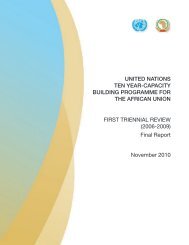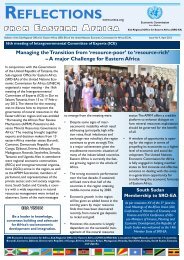Tool kit for Gender and Agriculture - Economic Commission for Africa
Tool kit for Gender and Agriculture - Economic Commission for Africa
Tool kit for Gender and Agriculture - Economic Commission for Africa
Create successful ePaper yourself
Turn your PDF publications into a flip-book with our unique Google optimized e-Paper software.
38<br />
Improving <strong>Agriculture</strong> through <strong>Gender</strong> Analysis<br />
Include gender issues in TORs of supervision missions.<br />
Assess progress on gender-related actions during mid-term reviews.<br />
Include gender-differentiated results in the lessons learned in implementation<br />
completion reports.<br />
• Prevent fade out:<br />
Emphasize gender issues in TORs of supervision, completion, <strong>and</strong> evaluation<br />
missions.<br />
Include a gender specialist on missions, particularly if (a) in<strong>for</strong>mation on<br />
gender roles is lacking, (b) the project design contains many problems related<br />
to gender roles, or (c) a special impact on women is required. The interest<br />
<strong>and</strong> ability of the person to work on gender issues is important,<br />
whereas their sex is not. A woman on the team cannot automatically be expected<br />
to take responsibility <strong>for</strong> gender: she may be untrained, uninterested,<br />
or unwilling.<br />
• Build flexibility into projects, particularly when not enough is known at preparation,<br />
so project actions can be modified during the project cycle to take advantage<br />
of new in<strong>for</strong>mation or opportunities.<br />
• Include safeguards⎯such as timed implementation targets or m<strong>and</strong>atory reporting⎯to<br />
ensure that attention to gender issues continues during the remainder of<br />
the project cycle.<br />
b. Modifications During the Project Cycle<br />
Acknowledging gender issues is relatively new in the design of Bank projects, so it<br />
will often be necessary to modify or adapt existing projects or components. Projects<br />
need the flexibility to make mid-course corrections in response to changes in agricultural<br />
production patterns, deficiencies in the original design, <strong>and</strong> a better underst<strong>and</strong>ing<br />
of gender issues than was available at preparation. Flexibility also enables projects to<br />
test promising approaches <strong>and</strong> exp<strong>and</strong> successful strategies.<br />
Many actions to modify ongoing projects are included among the examples by<br />
subsector in Chapter III. These actions more often represent a change in emphasis<br />
rather than addition of major new activities. Where it is difficult to identify genderrelated<br />
actions during project preparation because of inadequate in<strong>for</strong>mation, the project<br />
can include an unallocated fund earmarked <strong>for</strong> such initiatives. Such a fund will<br />
enable borrowers to identify activities <strong>and</strong> request funds at any time during the project<br />
cycle. The fund should constitute resources over <strong>and</strong> above the components identified<br />
with detailed costing. Such an unallocated fund can give a project flexibility, enhance<br />
institution building, <strong>and</strong> ensure that gender issues remain visible.<br />
3. Monitoring <strong>and</strong> Evaluation<br />
<strong>Gender</strong>-disaggregated evaluation is important when addressing gender in monitoring<br />
<strong>and</strong> evaluation of agriculture projects, <strong>for</strong> which several selection criteria <strong>for</strong> genderrelated<br />
indicators exist.







